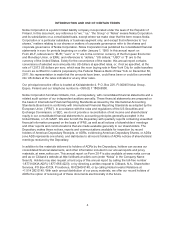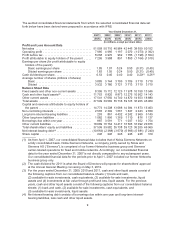Nokia 2011 Annual Report Download - page 15
Download and view the complete annual report
Please find page 15 of the 2011 Nokia annual report below. You can navigate through the pages in the report by either clicking on the pages listed below, or by using the keyword search tool below to find specific information within the annual report.3D. Risk Factors
Set forth below is a description of risk factors that could affect Nokia. There may be, however,
additional risks unknown to Nokia and other risks currently believed to be immaterial that could turn out
to be material. These risks, either individually or together, could adversely affect our business, sales,
profitability, results of operations, financial condition, market share, brand, reputation and share price
from time to time. Unless otherwise indicated or the context otherwise provides, references in these
risk factors to “Nokia”, “we”, “us” and “our” mean Nokia’s consolidated operating segments. Additional
risks primarily related to Nokia Siemens Networks that could affect Nokia are detailed under the
heading “Nokia Siemens Networks” below.
Our success in the smartphone market depends on our ability to introduce and bring to market
quantities of attractive, competitively priced Nokia products with Windows Phone that are
positively differentiated from our competitors’ products, both outside and within the Windows
Phone ecosystem, and receive broad market acceptance.
The mobile communications industry continues to undergo significant changes. The growing
significance of the Internet in communication has meant that the mobile telecommunications,
computing, consumer electronics and Internet industries are increasingly converging to form a broader
industry encompassing Internet-connected products of varying shapes and sizes. As a result, the
market for smartphones has shifted from a device oriented strategy to a platform oriented strategy.
Today, industry participants are creating competing ecosystems of mutually beneficial partnerships to
combine hardware, software, services and an application environment to create high-quality
differentiated smartphones. Certain smartphone platforms and their related ecosystems have gained
significant momentum and market share, specifically Apple’s iOS platform and Google’s Android
platform, and are continuing apace, with Android-based smartphones increasingly gaining market
share at lower price points. In February 2011, we announced our partnership with Microsoft to bring
together our respective complementary assets and expertise to build a new global mobile ecosystem
for smartphones (the “Microsoft partnership”). Under the Microsoft partnership, formalized in April
2011, we are adopting, and are licensing from Microsoft, Windows Phone as our primary smartphone
platform. Although Microsoft will continue to license Windows Phone to other mobile manufacturers,
the Microsoft partnership allows us to customize the Windows Phone platform with a view to
differentiating Nokia smartphones from those of our competitors that also use the Windows Phone
platform. The first Nokia smartphones powered by Windows Phone were launched in October 2011
under the Lumia brand.
Our plans to introduce and bring to market quantities of attractive, competitively priced Nokia products
with Windows Phone that receive broad market acceptance and are positively differentiated from
competitors’ products, both outside and within the Windows Phone ecosystem are subject to certain
risks and uncertainties, which could, either individually or together, significantly impair our ability to
compete effectively in the smartphone market. If we are not successful in the smartphone market, our
business would become more dependent on sales in the feature phone market, which is, especially at
lower price points, an increasingly commoditized and intensely competitive market, with substantially
lower growth potential, prices and profitability compared to the smartphone market. Recently,
smartphones of other manufactures, particularly Android-based smartphones, are reaching lower price
points, which is increasingly reducing the addressable market and lowering the price points for feature
phones and may adversely affect our feature phone business.
The principal risks and uncertainties that could undermine the competitive position of our Nokia
products with Windows Phone include the following:
• Our strategy for Nokia products with Windows Phone may not enable us to achieve in a timely
manner the necessary scale, product breadth, geographical reach and localization to be
sufficiently competitive in the smartphone market.
13
























